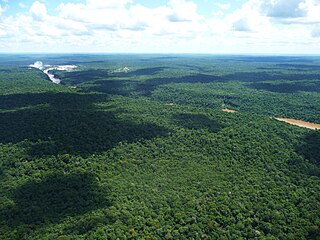
The Alto Paraná Atlantic forests, also known as the Paraná-Paraíba interior forests, is an ecoregion of the tropical moist forests biome, and the South American Atlantic Forest biome. It is located in southern Brazil, northeastern Argentina, and eastern Paraguay.

Megalobulimus is a genus of air-breathing land snail, a terrestrial gastropod mollusk in the subfamily Megalobuliminae within the family Strophocheilidae.

Megalobulimus parafragilior is a species of air-breathing land snail, a terrestrial pulmonate gastropod mollusk in the family Strophocheilidae.

Cananéia-Iguape-Peruíbe Environmental Protection Area is a protected area in the State of São Paulo, Brazil. It has been designated as a Ramsar site since 2017.
The Pardo River is a river in southeastern Brazil. For all of its length, it forms the border between the states of São Paulo and Paraná. It is a right tributary of the Ribeira de Iguape River, which flows into the Atlantic Ocean.

The Ribeira de Iguape River, or simply the Ribeira River, is a river of Paraná and São Paulo states in southeastern Brazil. It flows into the Atlantic Ocean near Iguape. The river is home to several endemic species of fish. So far no dams have been built on the river, although four have been proposed. Although it flows through a relatively sparsely populated region with untouched areas of Atlantic Forest, the river has been contaminated with heavy metals from mining beyond the point where it is considered safe to eat the molluscs found in the river and its estuary.
Wittrockia superba is a plant species in the genus Wittrockia.
Maytenus aquifolium, the espinheira-santa, is an endemic tree species endemic to the Atlantic Forest biome in southeastern Brazil.

Megalobulimus paranaguensis is a species of air-breathing land snail, a terrestrial gastropod mollusk in the family Strophocheilidae. They are native to South America and are known for being large and having a long lifespan. The survival rate of males is 96.7% and similarly high for other members of the species. Their eggs most often hatch in August and September and take around 51 days to hatch.

Megalobulimus jaguarunensis is a species of air-breathing land snails, a terrestrial gastropod mollusc in the family Strophocheilidae. This species was described from archaeological shell mounds, known as sambaquis, located in the city of Jaguaruna, Santa Catarina, southern Brazil.

The Jacupiranga Mosaic is a protected area mosaic of 14 units, located in the Atlantic Forest biome within the state of São Paulo of southeastern Brazil.

Vale do Ribeira is a region in the south of the state of São Paulo and the northeast of the state of Paraná, Brazil. It contains a large part of the Ribeira de Iguape River valley, from which it takes its name, as well as the coastal Iguape-Cananéia-Paranaguá estuary lagoon complex. The region is environmentally rich, with large areas of well-preserved Atlantic Forest, but economically poor.

The Paranapiacaba Conservation Units Mosaic is a protected area mosaic in the state of São Paulo, Brazil. It is administered by the state, and protects a large area of Atlantic Forest. It is associated with the Paranapiacaba Ecological Corridor of the Atlantic Forest Biosphere Reserve.

The Carlos Botelho State Park is a state park is the state of São Paulo, Brazil. It protects a mountainous area of Atlantic Forest. The park contains more than half of Brazil's remaining population of endangered southern muriqui, the largest primate in the Americas other than man.

The Xitué Ecological Station is an ecological station in the state of São Paulo, Brazil. It protects a mountainous area of Atlantic Forest.
The Jurupará State Park is a state park in the state of São Paulo, Brazil. It protects an area of Atlantic Forest, and provides a bridge between other conservation units in the region.
Mirinaba jaussaudi is a species of air-breathing land snail, a terrestrial pulmonate gastropod mollusk in the family Strophocheilidae. This species is endemic to Brazil, found in states of Paraná and São Paulo.
Mirinaba cadeadensis is a species of air-breathing land snail, a terrestrial pulmonate gastropod mollusk in the family Strophocheilidae. This species is endemic to Brazil.

Megalobulimus gummatus is a species of snail in the family Strophocheilidae found in Brazil.













